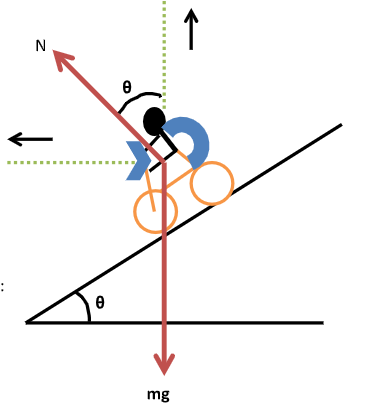
The angle of banking θ for a cyclist taking curve is given by \[\tan \theta = \dfrac{{{v^n}}}{{rg}}\], where symbols ($v$ =speed of the cyclist, $r$ = radius of the curved path, $g$ = acceleration due to gravity) have their usual meanings. Then the value of n is equal to
A. 1
B. 3
C. 2
D. 4
Answer
577.5k+ views
Hint: The appropriate value for n used in the expression \[\tan \theta = \dfrac{{{v^n}}}{{rg}}\] can be calculated with the help of (FBD) free body diagram of the cyclist which is taking turns on the banked road. After that, we apply Newton’s second law to establish the equations of motion for the cyclist along the vertical. Then analyze each component of forces acting on the cyclist separately to get the required value for n.
Complete step by step solution:
Applying Newton’s second law of motion along both the vertical and horizontal axis as:

Equation of motion along horizontal direction:
\[N\sin \theta = \dfrac{{m{v^2}}}{r}\]…… (i)
Equation of motion along vertical direction:
\[N\cos \theta = mg\]………. (ii)
Divide equation (ii) by equation (ii), we get
\[\dfrac{{N\sin \theta }}{{N\cos \theta }} = \dfrac{{\dfrac{{m{v^2}}}{r}}}{{mg}}\]
\[ \Rightarrow \dfrac{{\sin \theta }}{{\cos \theta }} = \dfrac{{{v^2}}}{{rg}}\]
\[\tan \theta = \dfrac{{{v^2}}}{{rg}}\]……………..(iii)
Since we have given that-
\[\tan \theta = \dfrac{{{v^n}}}{{rg}}\]…………(iv)
On comparing both equation (iii) and equation (iv), we get
\[n = 2\]
$\therefore $ The required value of $n=2$. Hence, option (C) is the correct answer.
Note:
In order to tackle these kinds of conceptual questions we should have knowledge of drawing FBD (Free Body Diagram) of a dynamic system and also know how to implement Newton’s second law motion for solving problems on Newton’s law. Banking of roads is developed on turning to avoid the dependence of friction.
From the equation (iii), we can also establish the expression that relates banking angle and radius with speed for a cyclist taking a curve on the banked road as-
\[v = \sqrt {rg\tan \theta } \]
This is actually a speed at which the cyclist does not slide down even the inclined surface is smooth. But there is some limiting value to stay on the same path while taking a turn:
(i) When the speed of the cyclist less than the speed \[\sqrt {rg\tan \theta } \] the cycle will move down while
(ii) When the speed of the cyclist is less than the speed \[\sqrt {rg\tan \theta } \] the cycle will move up to the inclined.
Complete step by step solution:
Applying Newton’s second law of motion along both the vertical and horizontal axis as:

Equation of motion along horizontal direction:
\[N\sin \theta = \dfrac{{m{v^2}}}{r}\]…… (i)
Equation of motion along vertical direction:
\[N\cos \theta = mg\]………. (ii)
Divide equation (ii) by equation (ii), we get
\[\dfrac{{N\sin \theta }}{{N\cos \theta }} = \dfrac{{\dfrac{{m{v^2}}}{r}}}{{mg}}\]
\[ \Rightarrow \dfrac{{\sin \theta }}{{\cos \theta }} = \dfrac{{{v^2}}}{{rg}}\]
\[\tan \theta = \dfrac{{{v^2}}}{{rg}}\]……………..(iii)
Since we have given that-
\[\tan \theta = \dfrac{{{v^n}}}{{rg}}\]…………(iv)
On comparing both equation (iii) and equation (iv), we get
\[n = 2\]
$\therefore $ The required value of $n=2$. Hence, option (C) is the correct answer.
Note:
In order to tackle these kinds of conceptual questions we should have knowledge of drawing FBD (Free Body Diagram) of a dynamic system and also know how to implement Newton’s second law motion for solving problems on Newton’s law. Banking of roads is developed on turning to avoid the dependence of friction.
From the equation (iii), we can also establish the expression that relates banking angle and radius with speed for a cyclist taking a curve on the banked road as-
\[v = \sqrt {rg\tan \theta } \]
This is actually a speed at which the cyclist does not slide down even the inclined surface is smooth. But there is some limiting value to stay on the same path while taking a turn:
(i) When the speed of the cyclist less than the speed \[\sqrt {rg\tan \theta } \] the cycle will move down while
(ii) When the speed of the cyclist is less than the speed \[\sqrt {rg\tan \theta } \] the cycle will move up to the inclined.
Recently Updated Pages
Why are manures considered better than fertilizers class 11 biology CBSE

Find the coordinates of the midpoint of the line segment class 11 maths CBSE

Distinguish between static friction limiting friction class 11 physics CBSE

The Chairman of the constituent Assembly was A Jawaharlal class 11 social science CBSE

The first National Commission on Labour NCL submitted class 11 social science CBSE

Number of all subshell of n + l 7 is A 4 B 5 C 6 D class 11 chemistry CBSE

Trending doubts
What is meant by exothermic and endothermic reactions class 11 chemistry CBSE

1 Quintal is equal to a 110 kg b 10 kg c 100kg d 1000 class 11 physics CBSE

What are Quantum numbers Explain the quantum number class 11 chemistry CBSE

What is periodicity class 11 chemistry CBSE

What is a periderm How does periderm formation take class 11 biology CBSE

Mention the basic forces in nature class 11 physics CBSE




